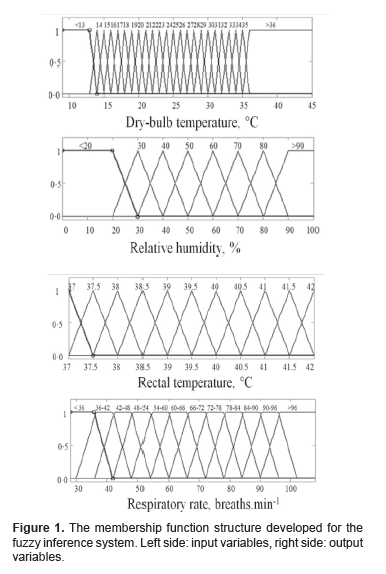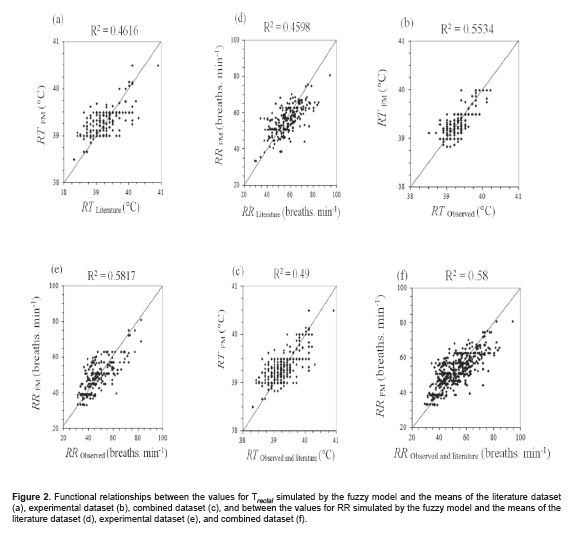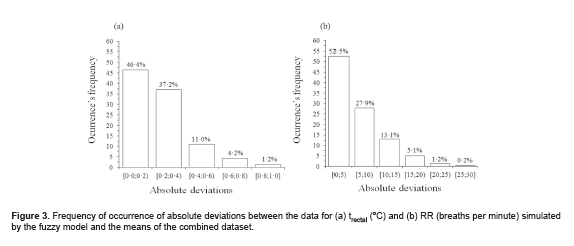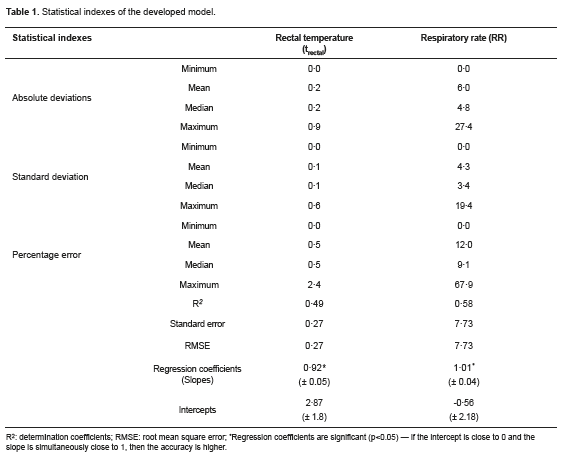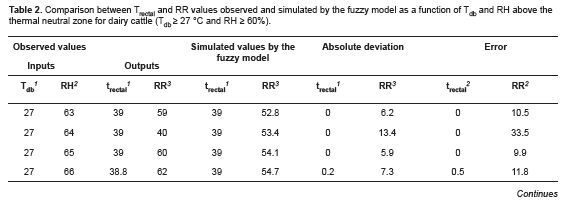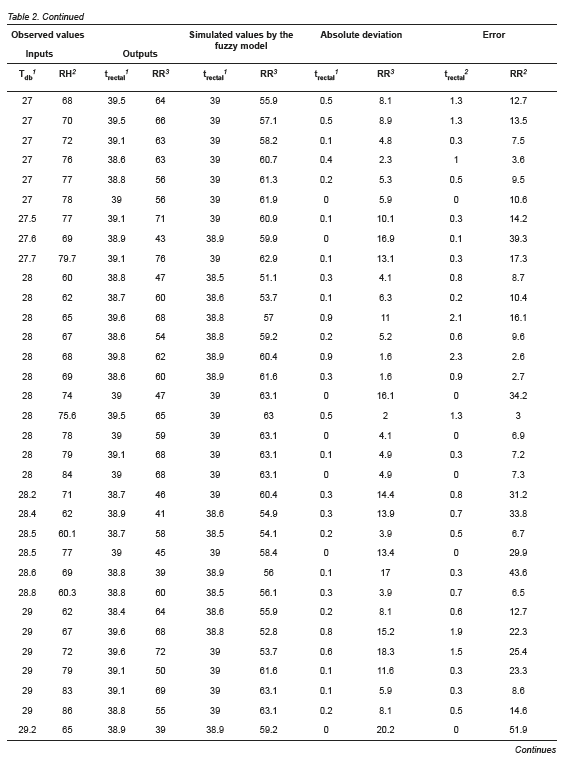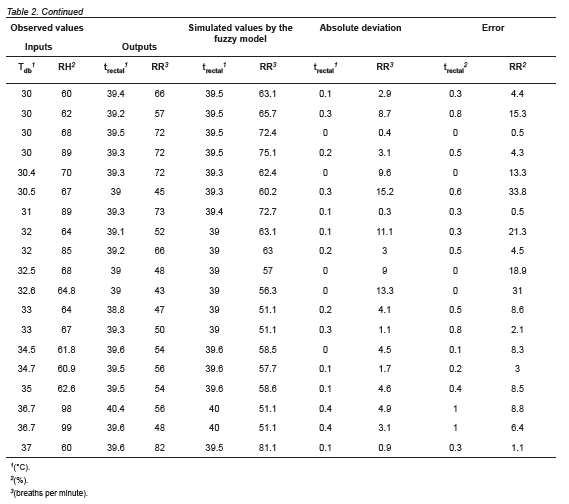Services on Demand
Journal
Article
Indicators
-
 Cited by SciELO
Cited by SciELO -
 Access statistics
Access statistics
Related links
-
 Cited by Google
Cited by Google -
 Similars in
SciELO
Similars in
SciELO -
 Similars in Google
Similars in Google
Share
Revista Colombiana de Ciencias Pecuarias
Print version ISSN 0120-0690
Rev Colom Cienc Pecua vol.28 no.1 Medellín Jan./Mar. 2015
ARTICLE
Fuzzy system to predict physiological responses of Holstein cows in southeastern Brazil¤
Sistema difuso para predecir respuestas fisiológicas de vacas Holstein en el sureste de Brasil
Sistema fuzzy para predizer respostas fisiológicas de vacas Holstein na região sudeste do Brasil
Oscar D Múnera Bedoya1*, Lic, Esp, MSc; Tadayuki Yanagi Junior2, Agric Eng, Esp, MSc, DSc; Maria F Ávila Pires3, MV, Esp, MSc, DSc; Marcos Aurélio Lopes4, Lic, Esp, MSc, DSc; Renato Ribeiro de Lima5, Zoot, MSc, DSc.
1Universidad del Sinú, Elías Bechara Zainúm, Facultad de Ciencias Económicas, Administrativas y Contables, Montería, Córdoba, Colombia.
2Universidade Federal de Lavras (UFLA), Departamento de Engenheira, Lavras, MG. PO Box 3037, CEP 37200-000, Lavras MG, Brazil.
3Empresa Brasileira de Pesquisa Agropecuária (EMBRAPA), Rua Eugênio do Nascimento, 610 Bairro Dom Bosco, CEP: 36038-330, Juiz de Fora, MG, Brazil.
4Universidade Federal de Lavras (UFLA), Departamento de Ciências Veterinárias, PO Box 3037, CEP 37200-000, Lavras, MG, Brazil.
5Universidade Federal de Lavras (UFLA), Departamento de ciências Exatas, PO Box 3037, CEP 37200-000, Lavras, MG, Brazil.
*Corresponding author: Yamid Fabián Hernández Julio. Calle 57 No. 11-120 casa 38, Balcones de la Castellana. Email: yafaheju@hotmail.com.
Received: September 25, 2013; accepted: July 2, 2014
Summary
Background:thermal environment exerts a direct influence on animal performance. Environmental factors, in different circumstances, may affect milk production and fertility of animals, compromising the profitability of the activity. Under heat stress conditions dairy cows reduce feed intake and, consequently, milk production. Sweating and panting are some of the mechanisms these animals use to relieve thermal stress. In addition, animals often suffer physiological and behavioral changes caused by heat stress.Objective: the goal of the present study was to develop and evaluate a model based on fuzzy set theory to predict rectal temperature (°C), and respiratory rate (breaths per minute) responses of Holstein cows exposed to different environmental thermal conditions. Methods: the proposed fuzzy model was based on data obtained experimentally (5,884 records) as well as from the literature (792 records) referring to the effect of environmental variables on both physiological responses. Input variables of each record were dry bulb air temperature and relative humidity. Output variables were rectal temperature and respiratory rate. Results: the adjusted model was evaluated for its ability to predict response variables as a function of input variables. The model was able to predict respiration rate with an average standard error of 7.73 and rectal temperature with an average standard error of 0.27. Conclusion: a fuzzy model was developed to predict physiological responses. The error (%) of model prediction for respiration rate and rectal temperature was +/- 12 and 0.5%, respectively.
Keywords: animal performance, predictive model, rectal temperature, respiratory rate.
Resumen
Antecedentes: el ambiente termal ejerce una influencia directa en el desempeño animal. Factores ambientales, en diferentes circunstancias, pueden afectar la producción de leche y la fertilidad de los animales, comprometiendo la rentabilidad de la actividad. Bajo condiciones de estrés por calor, las vacas lecheras reducen su consumo de alimento y, consecuentemente su producción de leche. Sudar y jadear son algunos de los mecanismos que estos animales usan para aliviar el estrés térmico. Además de estas consecuencias, los animales a menudo sufren cambios fisiológicos y comportamentales causados por el estrés calórico, causando una reducción en la producción de leche. Objetivo: el objetivo del presente estudio fue desarrollar y evaluar un modelo basado en la teoría de los conjuntos fuzzy para predecir respuestas fisiológicas, temperatura rectal y frecuencia respiratoria, de vacas lecheras de raza holandesa blanco y negro expuestas a diferentes condiciones ambientales. Métodos: el modelo fuzzy propuesto fue basado en datos obtenidos experimentalmente (5.884 registros), también como de la literatura (792 registros), refiriéndose a la influencia de las variables ambientales sobre esas respuestas fisiológicas. Cada registro incluye valores de temperatura de bulbo seco del aire, humedad relativa (variables de entrada), temperatura rectal y frecuencia respiratoria (variables de salida). Resultados: el modelo ajustado fue evaluado para cada variable respuesta y predice estas en función de las variables de entrada. Este modelo fue capaz de predecir la frecuencia respiratoria con un error estándar medio de 7,73 y la temperatura rectal con un error estándar medio de 0,27. Conclusión: un modelo fuzzy fue exitosamente desarrollado para predecir respuestas fisiológicas. El modelo fue capaz de predecir frecuencia respiratoria y temperatura rectal con errores porcentuales de +/- 12 y 0,5%, respectivamente.
Palabras clave: desempeño animal, frecuencia respiratoria, modelo predictivo, temperatura rectal.
Resumo
Antecedentes: o ambiente térmico exerce uma influencia direta no desempenho animal. Fatores ambientais, em diferentes circunstancias, podem afetar a produção de leite e a fertilidade dos animais, comprometendo assim a rentabilidade da atividade. Sobcondições de estresse por calor, as vacas leiteiras reduzem o seu consumo de alimento e, consequentemente, a sua produção de leite. Sudorese e respiração ofegante são alguns dos mecanismos que estes animais usam para aliviar o estresse térmico. Além destas consequências, os animais com frequência sofrem mudanças fisiológicas e comportamentais causados pelo estresse calórico, causando uma redução na produção de leite. Objetivo: o objetivo do presente estudo foi desenvolver e avaliar um modelo baseado na teoria dos conjuntos fuzzy para predizer respostas fisiológicas, temperatura retal e frequência respiratória, de vacas leiteiras de raça holandesa branca e preta, expostas a diferentes condições térmicas ambientais. Métodos: o modelo fuzzy proposto foi baseado em dados obtidos experimentalmente (5,884 registros) bem como da literatura (792 registros), referindo-se à influência das variáveis ambientais sobre essas respostas fisiológicas. Cada registro inclui valores de temperatura de bulbo seco do ar, umidade relativa (variáveis de entrada), temperatura retal e frequência respiratória (variáveis de saída). Resultados: o modelo ajustado foi avaliado para cada variável resposta e prediz estas em função das variáveis de entrada. Este modelo foi capaz de predizer a frequência respiratória com um erro padrão médio de 7,73 e a temperatura retal com um erro padrão médio de 0,27. Conclusão: o modelo fuzzy foi desenvolvido com sucesso para predizer respostas fisiológicas. O modelo foi capaz de predizer frequência respiratória e temperatura retal com erros percentuais de +/- 12 y 0,5%, respectivamente.
Palavras chave: desempenho animal, frequência respiratória, modelo preditivo, temperatura retal..
Introduction
Brazil is located in an inter-tropical zone with hot and humid climates where dissipating body heat into the environment presents a major problem for the cattle industry, especially dairy cattle (Almeida et al., 2010). High temperatures associated with high relative humidity in improperly designed confinement sheds further contribute to low performance of dairy cattle (Faria et al., 2008). The thermal environment exerts a direct influence on animal performance (Perissinotto and Moura, 2007). Environmental factors in different circumstances may affect milk production and fertility, compromising the profitability of the activity (Pierre et al., 2003; Ferro et al., 2010). The thermal environment affects heat transfer mechanisms and thus the thermal balance between the animal and the environment (Perissinotto and Moura, 2007; Navarini et al., 2009). Under heat stress conditions, dairy cows reduce feed intake and consequently milk production (Harner et al., 2009). Sweating and panting are some of the mechanisms these animals use to relieve thermal stress. In addition, animals often suffer physiological and behavioral changes causing a reduction in milk production (Perissinotto et al., 2007; Perissinotto et al., 2009). There is evidence that heat stress reduces future productivity of dairy cattle, even when environmental conditions return to acceptable levels (West, 2003; Hansen , 2007).
For these reasons, it is important to development models that can allow dairy producers to maintain a thermal neutral environment for the animals. Fuzzy models (FMs) can assist in ventilation control and evaporative cooling systems (Pereira et al., 2008).
Fuzzy models (FMs) are based on fuzzy logic (FL), which is founded in the theory of fuzzy sets introduced by Zadeh (1965). The FL works with approximate rather than exact information, similar to human reasoning, to achieve precision in various applications, thereby reducing the time needed for modeling. The fuzzy sets theory has been used as a viable and suitable option in various areas, such as estrus prediction in dairy cows (Ferreira et al., 2007), cloacal temperature prediction of broilers (Ferreira et al., 2012), statistics (Khashei et al., 2008), forensic science (Liao et al., 2009), among others.
The objective of this study was to develop and validate a model based on artificial intelligence (fuzzy logic) to predict rectal temperature (trectal) and respiratory rate (RR) of confined Holstein cows as a function of dry bulb air temperature (tdb) and relative humidity (RH).
Materials and methods
All procedures used in this experiment were approved by the Ethics Committee on Animal Use (Comissão de ética no uso de animais, CEUA) of the Federal University of Lavras (UFLA), protocol number 004/2011.
The experimental data used in this study were collected at the Intensive system of milk production (SIPL) facilities of the dairy cattle national research center (CNPGL) of the empresa brasileira de pesquisa agropecuária (EMBRAPA), Coronel Pacheco city, Minas Gerais (MG), Brazil. Environmental variables (tdb, RH) and physiological responses (trectal and RR) were collected. Output variables (physiological responses) and environment were evaluated simultaneously. Stalls occupied by cows were marked. The number of animals that occupied the stalls in relation to the total number of stalls was expressed as a percentage during the evaluation.
The SIPL is located at latitude 21°33'22'' S and longitude 43°06'15'' W, with an altitude of 414 m (Campos et al., 2002 ). The climate of the region corresponds to Cwa (i.e., hot weather, rainy temperate, a dry winter, and a hot summer). A free-stall shed with a capacity to accommodate 80 adult animals divided into four lots was evaluated (37.02 m long, 26.20 m wide, 7.00 m high at the center, and 3.50 m of ceiling height).
The shed had the following characteristics: full opening at all four sides, precast concrete pillars, slotted concrete floor for water and waste drain, central feed corridor (4.50 m wide), and handling corridor (3.82 m) to lead groups to the milking parlor. Beds were covered with sand, containing whole tires inside to reduce sand loss. The roof was covered in fiber cement tiles with an area of discovery ridge to obtain ventilation by thermosyphon effect. The gables were sealed with fiber cement tiles, installed in the vertical position, aiming to reduce the incidence of direct solar radiation inside the facility. Dry bulb thermometers were installed in the center of four stalls, in a row, with the objective of evaluating the temperature distribution in the facility. Additionally, air speed was collected at these points; however, this variable was not used in the proposed model.
Digital thermo-higrometers were installed in each stall to determine the following parameters: ambient temperature, relative humidity, maximum daily temperature, and maximum daily relative humidity. Maximum and minimum thermometers were also installed in a weather station located on the outside, near the shed dry bulb. Each set of 20 stalls was occupied by a group of animals, as follows: primiparous cows yielding between 25 to 30 kg/day (Group 1: G1); cows in early lactation (up to 100 days) and yielding above 25 kg/day (Group 2: G2); cows between 100 to 200 days of lactation and yielding between 20 to 25 kg/day (Group 3: G3); cows over 200 days of lactation and production between 12 to 20 kg/day (Group 4: G4). All animals were milked three times a day, at 6 a.m, at 2 p.m, and 10 p.m.
Recal temperature (Trectal) and RR were measured once a week at 9 a.m, 3 p.m, and 9 p.m during winter and summer in 50% of the animals, which were drawn at random within each group. The average number of sampled animals was 40 (10 per group) on each harvest. trectal was obtained through a clinical digital thermometer inserted into the rectum, and RR by counting flank movements for 30 seconds and multiplying this value by 2 to get the number of breaths per minute. Care was taken to prevent animal movements when measuring trectal and RR. Data collection was conducted by the same personnel throughout the experimental period.
Datasets
A database was generated based on literature (thesis and dissertations included), containing the raw data for tdb, RH, trectal, and RR for black and white Holstein dairy cows exposed to different environmental thermal conditions. These data were chosen because the authors Pires (1997), Martello (2002), Silva et al. (2002), Perissinotto (2003), Pires and Campos (2003), Martello et al. (2004), Matarazzo (2004), and worked with these four variables in common.
The total dataset, also called a combined dataset (6,676 records), was obtained from 128 multiparous Holstein dairy cows reported in different experiments in the literature (also called the Literature dataset, 792 records) and data from experiments conducted by EMBRAPA in MG, Brazil. For this experiment, 346 multiparous purebred Holstein cows were used. The free-stall environment was continuously monitored to obtain daily records of tdb and RH in the winter period (June, July, and August) and summer (January, February, and March) during years 1993, 1994, and 1995. The trectal and RR were collected once a week, three times a day (9 a.m, 3 p.m, and 9 p.m), thereby obtaining 5,884 records (also called the Experimental dataset).
The total number of animals used for data collection was 474. The dataset included all seasons. All animals were located in Southeastern Brazil. This region fits in the Cwa Köppen climatic classification, with dry, cold winters and hot, humid summers. The combined dataset used (experimental and obtained from literature) in this study covered a total period of six years.
To develop and validate the model based on fuzzy logic, the dataset used were the means of the combined dataset. This dataset had a total of 427 means (216 means from the Literature dataset and 211 means from the Experimental dataset).
Data analysis
Once developed, the model was tested using the minimum, mean, median, maximum values, standard deviation, and percentage errors. Standard errors, coefficients of determination (R2), root mean square error (RMSE), regression coefficients (slopes), and intercepts for each variable (trectal and RR) were also calculated using the SPSS® statistical software package (SPSS Inc., Chicago, Illinois, USA). In addition, histograms and graphs of functional relationships (FRs)—FRs between (with linear trend) predicted and observed variables (means of the combined dataset), were used to compare the performance of the proposed model.
Fuzzy inference system
The computer program used to make the model was Matlab® 2009a (MatWorks Inc, Natick, MA, USA), using the fuzzy logic toolbox®. The model consists of two input variables (tdb and RH) and two output variables (trectal and RR). The most common inference method used by researchers (Perissinotto et al., 2009; Yanagi Junior et al., 2012; Ponciano et al., 2012; Campos et al., 2013) and used in this study was the Mandani type (Mandani and Assilian, 1975), which creates a fuzzy set originating from combining input values with their respective pertinence degree, by the minimum operator and then by superposition of the rules through maximum operator. De-fuzzification was performed using the method of Center of Gravity (Centroid or Area Center), which considers all output possibilities, transforming the fuzzy set originated by inference into a numerical value, as proposed by Tanaka (1997) and Sivanandam et al. (2007). In this type of FM, much intervention is required from the modeler because FM can be generated with experimental data; therefore, the total of means of the combined dataset was used for validation of the model. Because of modeler intervention, a spreadsheet was used to organize the data (in this case, the means of the combined dataset, 427 independent data points) to establish the set of rules that might explain the behavior of input and output variables.
The classifications adopted for this model were based on the literature and through the assistance of experts (specialists), in the form of linguistic sentences, and the fit between the simulated and observed values. The selection process of specialists interferes with the reliability of the results (Taylor, 1988), therefore, experts were selected from heterogeneous groups with extensive experience (more than 10 years) in the area of animal environment. Specialists had theoretical knowledge gained through research, development of courses and conferences on the subject, in accordance with the fuzzy specialists selection methodology proposed by Cornelissen et al. (2002). Three specialists developed this model, in agreement to the amount proposed by Klir and Yuan (1995; one or more).
Results
According to the analysis of the experimental dataset, the sources of variation considered in the statistical model (year, season, time, group) had significant effect (p<0.01) on the variables trectal and RR. The time x group x time x season and group interactions were not significantly different for both variables, and station group x time x and year x season did not differ respect to RR.
The season (winter or summer) explained part of the model for trectal (R2 = 43.3%) and RR (R2 = 71.82%), and time of collection was more important to the model for trectal (R2 = 23.5%) than for RR (R2 = 10.5%).
Fuzzy inference system
The result of this fuzzy inference system can be described as a set of membership functions based on linguistic descriptors of input variables (Figure 1). Initially, this model was based on research by Perissinotto (2007) and Perissinotto et al., (2009), which has 120 rules (tdb = 15, membership functions (MFs), range [15 to 45 °C]; temperature sets: {< 22, 23, 24, 25, 26, 27, 28, 29, 30, 31, 32, 33, 34, 35, e > 36}; RH = 8 MFs, range [0 to 100%]; humidity sets {< 20, 30, 40, 50, 60, 70, 80, e > 90}; trectal = 3, MFs, range [37% to 40 °C]; sets {< 38.8, 38.8 - 39.2, > 39.2 °C}; and RR = 3 MFs, range [28 to 108 breaths/ min]; sets: {< 56, 56 to 64, > 64}). These MFs values were adjusted according to the experimental dataset to reduce deviations, because the model proposed by Perissinotto (2009) and the raw data obtained by Perissinoto (2003) did not have values lower than 22 °C for tdb, and values greater than 40 °C for trectal, thus, the model with these configuration (sets), had absolute deviations greater than 1.0 °C.
The linguistic expressions established in this model are an interpretation dependent on the previously organized data. The structural characteristics of the model are: type: Mandani; number of rules: 192; defuzzification method: Centroid; input 1 (tdb), range: 9 to 45; number of MFs: 24; input 2 (RH), range: 0 to 100; number of MFs: 8; as output 1 (trectal), range: 37 to 42; number of MFs: 11 and output 2 (RR), range: 28 to 108; number of MFs: 12.
The fuzzy sets of input and output variables are graphically represented by triangular and trapezoidal membership curves (Figure 1) because these are the most commonly used and represent the data profile, as observed by several authors (Ferreira et al., 2007; Schiassi et al., 2008; Perissinnoto et al., 2009; Castro et al., 2012; Ponciano et al., 2012; Campos et al., 2013).
The fuzzy inference was composed of a set of 192 rules, stemming from the multiplication of 24 MFs for tdb and 8 MFs for RH. Each rule was composed of logical connectors (if, and, or, then) and the antecedent and consequent parts. For example, IF x is A AND y is B, THEN z is C, in which A, B, and C are fuzzy sets; 'x' and 'y' are input variables; and z is the output variable. Thus, ''IF x is A AND y is B'' is the antecedent part, and ''THEN z is C'' is the consequent part.
The FRs between values for trectal and RR predicted by the FM and the means of the literature dataset, means of the experimental dataset, and the means of the combined dataset (means of experimental and literature datasets) are shown in Figure 2.
In addition to the graphs that illustrate the FRs previously described for the fitted model, histograms for the occurrence frequency of absolute deviations for trectal (Figure 3a) and RR (Figure 3b) are presented; thus, statistical results are shown in Table 1, some samples of values for trectal and RR (measured experimentally and simulated using the proposed fuzzy model) are listed in Table 2.
Discussion
The final model for predicting trectal and RR in cows was compared side by side using different methods with the means of the combined dataset as validation of the model. The model generally exhibited good statistical indices related to capacity for predicting the physiological variables.
The fitted model more accurately predicts the trectal than the RR (Tables 1 and 2). This result may be attributable to the fact that Holstein cows have lower adaptability to adverse conditions of hot climates and they need to activate their thermoregulatory mechanisms more intensely to dissipate body heat through the respiratory tract (Azevedo et al., 2005), where each animal reacts differently in an attempt to maintain homeothermy. Above the upper critical temperature (25 °C), dairy cattle increase respiratory rate and trectal concomitant with a decline of milk production and reproductive performance (Bitman et al., 1984). The increase in respiratory frequency allows the animal to reduce body heat by 30% through evaporation. Respiratory rate is an index of respiratory thermoregulation, thus, when high RR is observed and the animal efficiently dissipates body heat, heat stress may not occur (Pires and Campos, 2003). Therefore, at the time of collecting information for this variable for each animal, it is possible to find more variation within established normal ranges and affect the coefficient of variation of the data collected of this variable (RR) and the values of trectal may stay more stable within the normal ranges in the respective experiments.
In addition, it is evident that the model developed predicted with greater accuracy (higher R2) when using the observed dataset compared to the literature dataset (Figure 2). This might be explained by differences in management, thermal isolation of facilities, and use of ventilation and evaporative cooling systems intrinsic to each experiment reported in the literature.
In the specialists' opinion, the inclusion of air velocity and radioactive heat load as input variables may increase model performance because tdb affects loss of sensible heat through conduction and convection, RH affects quantity of latent heat lost, and air velocity affects rate of loss of sensible and latent heat (Dikmen and Hansen, 2009), thereby reducing the prediction errors.
A more detailed analysis of the frequency of absolute deviations reveals that for the means of the combined dataset of trectal predicted by the model, 83.6% of absolute deviations were between 0.0 and 0.39 °C, and the remaining 16.4% were between 0.4 and 1.0 °C (Figure 3a), thus, indicating the model's predictive capacity.
Similarly, according to the model predicting the means of the combined dataset for RR, 80.4% of the absolute deviations were between 0.0 and 9.9 breaths per minute, and the remaining 19.6% were between 10.0 and 30.0 breaths per minute (Figure 3b).
The prediction capacity of trectal by the fuzzy model was greater than that reported by Hernández- Julio et al. (2012) using a Sugeno type fuzzy system developed by an adaptive neuro-fuzzy Inference system (ANFIS) to predict the same variable (trectal) with a 0.442 coefficient of determination (R2). This study had better performance than the reported by the previously mentioned author (standard error = 0.28; root mean square error (RMSE) = 0.28), the difference between the two models is that 94.6% of the absolute deviations were between 0.0 °C and 0.39 °C, and the remaining 5.4% were between 0.4 and 1.0 °C.
This fuzzy model was greater than the work reported by Azevedo et al. (2005) and Dikmen and Hansen (2009) using regression models to predict physiological variables (trectal, RR and coat temperature with coefficient of determination [R2] of 0.43, 0.62, and 0.31, respectively for first author and trectal with R2 = 0.43 for the latter), emphasizing that the published studies used fewer statistical resources for the evaluation of the proposed models.
For RR, on one hand, the fitted model presented a greater R2 and a lower mean error than the model reported in a similar work by Brown-Brandl et al. (2005) who used fuzzy logic to predict RR (R2 = 0.27; Mean error = 8.0). In the same case, this work presented higher R2 than the studies reported by Martello (2006) who worked with regression models to predict this physiological variable (R2 = 0.43) and the work reported by Hernández-Julio et al. (2012) who used a Sugeno type fuzzy system (ANFIS) to predict RR with a coefficient of determination value of 0.44, also obtaining better results than the model reported (standard error of 8.99 and RMSE of 9.12), the difference between the two fuzzy models was in the frequency of occurrence of absolute deviations (90.2% were between 0.0 and 9.9 breaths per minute, and the remaining 9.8% of the deviations were between 10.0 and 30.0 breaths per minute).
On the other hand, the work reported by Azevedo et al. (2005) presented higher R2 for RR than this fitted model. This result can be explained by the characteristic of the study. The animals used had different levels of crossbreeding (1/2, 3/4, 7/8) between Holstein and Zebu, showing that these animals have less need to use their respiratory tract to maintain homeothermy, which is probably derived from the fact that these animals are better able to regulate heat loss through skin perspiration (Azevedo et al., 2005). This allows researchers to obtain continuous data and, thereby, to establish better results by reducing prediction errors.
The fuzzy model developed to estimate the trectal and RR of black and white Holstein dairy cows based on the tdb and RH provided low standard deviations and percentage errors (0.1 °C and 0.5% for trectal respectively; 4.3 breaths per minute and 12% for RR, respectively). Thus, the model based on fuzzy logic generates realistic estimates and can be used to predict physiological responses of Holstein cows and can thus help in the decision-making process.
Acknowledgements
The authors express their deep gratitude to CNPq, MRE, CAPES, and FAPEMIG for supporting this research.
Conflicts of interest
The authors declare they have no conflicts of interest with regard to the work presented in this report.
Notes
¤ To cite this article: Hernández Julio YF, Yanagi Junior T, Ávila Pires MF, Lopes MA, Ribeiro de Lima R. Fuzzy system to predict physiological responses of Holstein cows in southeastern Brazil. Rev Colomb Cienc Pecu 2015; 28:42-53.
References
Almeida GLP, Pandorfi H, Guiselini C, Almeida GAP, Morril WBB. Investimento em climatização na pré-ordenha de vacas girolando e seus efeitos na produção de leite. Rev Bras Eng Agríc Ambient 2010; 14(12):1337-1344. [ Links ]
Azevedo M, Pires MFA, Saturnino HM, Lana AMQ, Sampaio IBMS, Morato LE. Estimativa de níveis críticos superiores do índice de temperatura e umidade para vacas leiteiras 1/2, 3/4, 7/8 Holandês-Zebu em lactação. Rev Bras Zootecn 2005; 34(6). [ Links ]
Bitman J, Lefcourt A, Wood D, Stroud B. Circadian and ultradian temperature rhythms of lactating dairy cows. J Dairy Sci 1984; 67:1014-1023. [ Links ]
Brown-Brandl TM, Jones DD, Woldt WE. Evaluating modelling techniques for cattle heat stress prediction. Biosyst Eng 2005; 91(4):513-524. [ Links ]
Campos AT, Castro JdO, Schiassi L, Yanagi Junior T, Pires MdFÁ, Mattioli CC. Prediction of free-stall occupancy rate in dairycattle barns through fuzzy sets. Eng Agríc 2013; 33:1079-1089. [ Links ]
Campos AT, Ferreira WA, Paccola AA, Lucas Júnior J, Ulbanere RC, Cardoso RM, Campos, AT. Tratamento biológico aeróbio= Campus, AT e reciclagem de dejetos de bovinos, em sistema intensivo de produção de leite. Ciênc Agrotec 2002; 26(2):426-438. [ Links ]
Castro JO, Veloso AV, Yanagi Junior T, Fassani EJ, Schiassi L, Campos AT. Estimate of the weight of japanese quail eggs through fuzzy sets theory. Cienc Agrotec 2012; 36:108-116. [ Links ]
Cornelissen AMG, Van Den berg J, Koops WJ, Kaymak U. Eliciting expert knowledge for fuzzy evaluation of agricultural production systems. ERIM 2002; (25):1-33. [ Links ]
Dikmen S, Hansen PJ. Is the temperature-humidity index the best indicator of heat stress in lactating dairy cows in a subtropical environment? J Dairy Sci 2009; 92(1):109-116. [ Links ]
Faria FF, Moura DJ, Souza ZM, Matarazzo SV. Viabilidade espacial do microclima de um galpão utilizado para confinamento de bovinos de leite. Cienc Rural 2008; 38(9):2498-2505. [ Links ]
Ferreira L, Yanagi Junior T, Nääs IA, Lopes MA. Development of algorithm using fuzzy logic to predict estrus in dairy cows: Part I. CIGR Journal 2007; 9:1-16. [ Links ]
Ferreira L, Yanagi Junior T, Lacerda WS, Rabelo GF. A fuzzy system for cloacal temperature prediction of broiler chickens. Cienc Rural 2012; 42(1):166-171. [ Links ]
Ferro FRA, Cavalcanti Neto CC, Toledo Filho MR, Ferri STS, Montaldo YC. Efeito do estresse calórico no desempenho reprodutivo de vacas leiteira. Rev Verde agroecologia Desenvolv Sustent 2010; 5(5):1-25. [ Links ] [ Links ]
Harner JP, Smith JF, Bradford BJ, Overton M, Dhuyvetter KC. In the Thermoneutral Zone: Potential benefits of LPCV buildings. In: Western Dairy Management Conference; Reno March 11-13. Reno: Kansas State University; 2009. p. 27-41. [ Links ]
Hernández-Julio YF, Yanagi Junior T, Pires MFA, Lopes MA, Lima RR. Prediction of physiological responses of holstein dairy cows. In: ASABE Annual International Meeting; Dallas July 31. Dallas: ASABE; 2012. [ Links ]
Khashei M, Reza Hejazi S, Bijari M. A new hybrid artificial neural networks and fuzzy regression model for time series forecasting. Fuzzy Set Syst 2008; 159(7):769-786. [ Links ]
Klir GJ, Yuan B. Fuzzy sets and fuzzy logic: theory and applications. New Jersey (NJ): Prentice Hall; 1995. [ Links ]
Liao N, Tian S, Wang T. Network forensics based on fuzzy logic and expert system. Comput Commun 2009; 32(17):1881-1892. [ Links ]
Mandani EH, Assilian S. An experiment in linguistic synthesis with a fuzzy logic controller. Int J Man Mach Stud 1975; 7(1):1-13. [ Links ]
Martello LS. Diferentes recursos de climatização e sua influência na produção de leite, na termorregulação dos animais e no investimento das instalações [Dissertação de Mestrado]. Pirassununga, SP: Universidade de São Paulo; 2002. [ Links ]
Martello LS. Interação animal-ambiente: efeito do ambiente climático sobre as respostas fisiológicas e produtivas de vacas holandesas em free-stall. [PhD. Thesis]. Pirassununga, SP: Universidade de São Paulo; 2006. [ Links ]
Martello LS, Savastano Júnior H, Silva SdLe, Titto EAL. Respostas fisiológicas e produtivas de vacas holandesas em lactação submetidas a diferentes ambientes. R Bras Zootec 2004; 33:181-191. [ Links ]
Matarazzo SV. Eficie^ncia do sistema de resfriamento adiaba'tico evaporativo em confinamento do tipo ''Freestall'' para vacas em lactac¸a~ o [Tese de doutorado]. Piracicaba, SP: Escola Superior de Agricultura ''Luiz de Quiroz''-Universidade de São Paulo; 2004. [ Links ]
Navarini FC, Klosowski ES, Campos AT, Teixeira RA, Almeida CP. Conforto térmico de bovinos da raça nelore a pasto sob diferentes condições de sombreamento e a pleno sol. Eng Agríc 2009; 29(4):508-517. [ Links ]
Pereira DF, Bighi CA, Gabriel Filho LR, Gabriel CPC. Sistema fuzzy para estimativa do bem-estar de matrizes pesadas. Eng Agric 2008; 28:624-633. [ Links ]
Perissinotto M. Avaliação da eficiência produtiva e energética de sistemas de climatização em galpões tipo freestall para confinamento de gado leiteiro [Dissertação de mestrado]. Piracicaba, SP: Escola Superior de Agricultura ''Luiz de Queiroz''- Universidade de São Paulo; 2003. [ Links ]
Perissinoto M. Sistema inteligente aplicado ao acionamento do sistema de climatização em instalações para bovinos leiteiros [PhD Thesis]. Piracicaba, SP: Universidade de São Paulo, Escola Superior de Agricultura ''Luiz de Queiroz''; 2007. [ Links ]
Perissinotto M, De Moura DJ. Determinação do conforto térmico de vacas leiteras utilizando a mineração de dados. BioEng - Rev Bras Eng Biosis 2007; 1(2):117-126. [ Links ]
Perissinotto M, De Moura DJ, Cruz VF. Avaliação da produção de leite em bovinos utilizando diferentes sistemas de climatização. Rev de Ciênc Agrár 2007; 30(1):135-142. [ Links ]
Perissinotto M, Moura DJ, Cruz VF, Souza SRLd, Lima KAOd, Mendes AS. Conforto térmico de bovinos leiteiros confinados em clima subtropical e mediterrâneo pela análise de parâmetros fisiológicos utilizando a teoria dos conjuntos fuzzy. Cienc Rural 2009; 39:1492-1498. [ Links ]
Pierre NR, Cobanov B, Schnitkey G. Economic losses from heat stress by US livestock industries. J Dairy Sci 2003; 86 Suppl E52-E77. [ Links ]
Pires MFA. Comportamento, parâmetros fisiológicos e reprodutivos de fêmeas da raça holandesa confinadas em free stall, durante o verão e o inverno [PhD Thesis]. Belo Horizonte, MG: Universidade Federal de Minas Gerais; 1997. [ Links ]
Pires MFA, Campos ATd. Relação dos dados climáticos com o desempenho animal. In: Resende H, Campos AT, Pires MFA, editors. Meteorologia e sua aplicação na atividade leiteira. Juiz de Fora: EMBRAPA Gado de Leite; 2003. p.103-114. [ Links ]
Ponciano PF, Yanagi Junior T, Schiassi L, Campos AT, Nascimento JWBd. Sistema fuzzy para predição do desempenho produtivo de frangos de corte de 1 a 21 dias de idade. Eng Agric 2012; 32:446-458. [ Links ]
Schiassi L, Yanagi Junior T, Ferreira L, Damasceno FA, Yanagi SNM. Metodologia fuzzy aplicada à avaliação do aumento da temperatura corporal em frangos de corte. Eng Agric 2008; 16:180-191. [ Links ]
Silva IJOd, Pandorfi H, Acararo Jr. I, Piedade SMS, Moura DJd. Efeitos da climatização do curral de espera na produção de leite de vacas holandesas. R Bras Zootec 2002; 31:2036-2042. [ Links ]
Sivanandam SN, Sumathi S, Deepa SN. Introduction to fuzzy logic using matlab. Berlin: Springer-Verlag; 2007. [ Links ]
Tanaka K. An introduction to fuzzy logic for practical applications. Tokyo: Springer; 1997. [ Links ]
Taylor J. Delphi method applied to tourism. In: Wittis ML, editor. Tourism marketing and management handbook. New York, NY: Prentice Hall; 1988. p. 95-99. [ Links ]
West JW. Effects of heat-stress on production in dairy cattle. J Dairy Sci 2003; 86:2131-2144. [ Links ]
Yanagi Júnior T, Schiassi L, Abreu LHP, Barbosa JA, Campos AT. Procedimento fuzzy aplicado à avaliação da insalubridade em atividades agrícolas. Eng Agríc 2012; 32(3):423-434. [ Links ]
Zadeh LA. Fuzzy sets. Inform Control 1965; 8:338-353. [ Links ]













